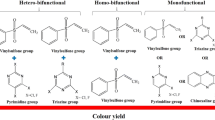Abstract
The dyeability of cotton fabrics with reactive dye, in non-aqueous alkane medium of heptane and octane was investigated using a non-ionic surfactant reverse-micellar approach comprising of poly(ethylene glycol)-based surfactant. The reactive dye was satisfactorily encapsulated in the cavity of the reverse micelle under the optimised process parameters as measured by the colour yield. Dyeability of cotton fibre with reactive dye from the reverse micellar solution was improved even in the absence of electrolytes. Optimisation of dyeing and fixation process could be achieved in a one-bath reverse-micelle solution. Experimental results revealed that dyeability in the alkane-assisted dyeing process is better than that in conventional water-based dyeing without incorporation of electrolytes. The scanning electron microscopic images showed no obvious surface damage from heptane or octane but some microfibrils were noticed.













Similar content being viewed by others
References
Acharya S, Abidi N, Rajbhandari R, Meulewaeter F (2014) Chemical cationization of cotton fabric for improved dye uptake. Cellulose 21:4693–4706
Allegre C, Moulin P, Maisseu M, Charbit F (2006) Treatment and reuse of reactive dyeing effluents. J Membr Sci 269:15–34
Barzykin AV, Tachiya M (1994) Reaction kinetics in microdisperse systems with exchange. J Phys Chem 98:2677–2687
Bird CL, Boston WS (1975) The theory of coloration of textiles. Dyers Company Publications Trust, Bradford
Chavan RB, Subramanian A (1983) Dyeing cotton with a reactive dye from polar-nonpolar solvent systems. Text Res J 53:539–543
Clarke MJ, Harrison KL, Johnston KP, Howdie SM (1997) Water in supercritical carbon dioxide microemulsions: spectroscopic investigation of a new environment for aqueous inorganic chemistry. J Am Chem Soc 119:6399–6406
De T, Maitra A (1995) Solution behavior of aerosol OT in non-polar solvents. Adv Colloid Interface Sci 59:95–193
Elmaaty TA, El-Aziz EA, Ma J, El-Taweel F, Okubayashi S (2015) Eco-friendly disperse dyeing and functional finishing of nylon 6 using supercritical carbon dioxide. Fibers 3:309–322
Fendler JH (1982) Membrane mimetic chemistry: characterizations and applications of micelles, microemulsions, monolayers, bilayers, vesicles, host-guest systems, and polyions. Wiley, New York
Fersi C, Dhahbi M (2008) Treatment of textile plant effuent by ultrafltration and/or nanofltration for water reuse. Desalination 222:263–271
Gashti MP, Moradian S (2012) Effect of nanoclay type on dyeability of poly(ethylene terephthalate)/clay nanocomposites. J Appl Polym Sci 125:4109–4120
Gashti MP, Rashidian R, Almasian A, Zohouri AB (2013) A novel method for coloration of cotton using clay nano-adsorbent treatment. Pigm Resin Technol 42:175–185
Harrison K, Goveas J, Johnston KP, O’RearIII EA (1994) Water-in-carbon dioxide microemulsions with a fluorocarbon-hydrocarbon hybrid surfactant. Langmuir 10:3536–3541
Hashem M, Hauser PJ, Smith B (2003) Reaction efficiency for cellulose cationization using 3-chloro-2-hydroxypropyl trimethyl ammonium chloride. Text Res J 73:1017–1023
Hickman WS (1993) Environmental aspects of textile processing. J Soc Dyers Colour 109:32–37
Ikushima Y, Saito N, Goto T (1989) Selective extraction of oleic, linoleic, and linolenic acid methyl esters from their mixture with supercritical carbon dioxide-entrainer systems and a correlation of the extraction efficiency with a solubility parameter. Ind Eng Chem Res 28:1364–1369
Johnston KP, Harrison KL, Clarkes MJ, Howdle SH, Heitz MP, Bright FV, Carlier C, Randolph TW (1996) Water-in-carbon dioxide microemulsions: an environment for hydrophiles including proteins. Science 271:624–626
Kanik M, Hauser PJ (2004) Printing cationized cotton with direct dyes. Text Res J 74:43–50
Knittel D, Saus W, Schollmeyer E (1993) Application of supercritical carbon dioxide in finishing processes. J Text Inst 84:534–552
Kumar C, Balasubramanian D (1980) Spectroscopic studies on the microemulsions and lamellar phases of the system triton X-100: hexanol: water in cyclohexane. J Colloid Interface Sci 74:64–70
Liao SK (2004) Dyeing nylon-6,6 with some hydrophobic reactive dyes by supercritical processing. J Polym Res 11:285–291
Liao SK, Ho YC, Chang PS (2000) Dyeing of Nylon-6,6 with a disperse-reactive dye using supercritical carbon dioxide as the transport medium. Color Technol 116:403–407
Marcucci M, Nosenzo G, Capannelli G, Ciabatti I, Corrieri D, Ciardelli G (2001) Treatment and reuse of textile effluents based on new ultrafiltration and other membrane technologies. Desalination 138:75–82
Matijevic E (1993) Surface and colloid science, vol 15. Springer, New York
Montazer M, Malek RMA, Rahimi A (2007) Salt free reactive dyeing of cationized cotton. Fibers Polymers 8:608–612
Patiño A, Canal C, Rodríguez C, Caballero G, Navarro A, Canal JM (2011) Surface and bulk cotton fibre modifications: plasma and cationization. Influence on dyeing with reactive dye. Cellulose 18:1073–1083
Pileni MP (1989) Structure and reactivity in reverse micelles. Elsevier, Amsterdam
Pileni MP (1993) Reverse micelles as microreactors. J Phys Chem 97:6961–6973
Reife A, Freeman HS (1996) Environmental chemistry of dyes and pigments. Wiley, New York
Saus W, Knittel D, Schollmeyer E (1992) Färben aus überkritischem Kohlendioxideine lternative zur HT-Fäbung von polyester. Textil Praxis International 47:1052–1054
Sawada K, Ueda M (2003) Adsorption and fixation of a reactive dye on cotton in non-aqueous systems. Color Technol 119:182–186
Sawada K, Ueda M (2004) Characteristics of aqueous microenvironments in non-ionic surfactant reverse micelles and their use for enzyme reactions in non-aqueous media. J Chem Technol Biotechnol 79:369–375
Sawada K, Takagi T, Ueda M (2004) Solubilization of ionic dyes in supercritical carbon dioxide: a basic study for dyeing fiber in non-aqueous media. Dyes Pigm 60:129–135
Vandevivere PC, Bianchi R, Verstraete W (1998) Treatment and reuse of wastewater from the textile wet-processing industry: review of emerging technologies. J Chem Technol Biotechnol 72:289–302
Wang L, Ma W, Zhang S, Teng X, Yang J (2009) Preparation of cationic cotton with two-bath pad-bake process and its application in salt-free dyeing. Carbohydr Polymer 78:602–608
Yi SX, Dong YC, Li B, Ding ZZ, Huang XB, Xue LX (2012) Adsorption and fixation behaviour of CI Reactive Red 195 on cotton woven fabric in a nonionic surfactant Triton X-100 reverse micelle. Color Technol 128:306–314
Acknowledgments
Authors would like to thank the financial support from the Hong Kong Polytechnic University for this work.
Author information
Authors and Affiliations
Corresponding author
Rights and permissions
About this article
Cite this article
Wang, Y., Lee, Ch., Tang, Yl. et al. Dyeing cotton in alkane solvent using polyethylene glycol-based reverse micelle as reactive dye carrier. Cellulose 23, 965–980 (2016). https://doi.org/10.1007/s10570-015-0831-8
Received:
Accepted:
Published:
Issue Date:
DOI: https://doi.org/10.1007/s10570-015-0831-8



